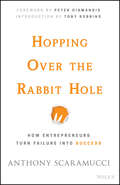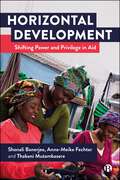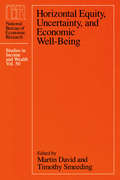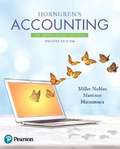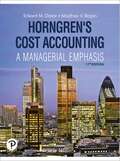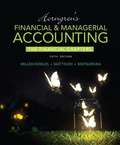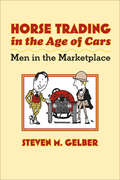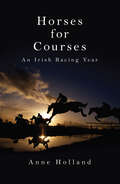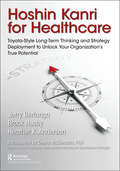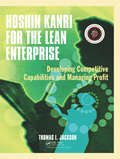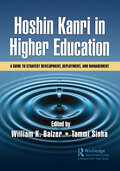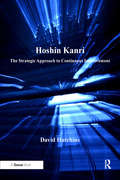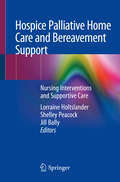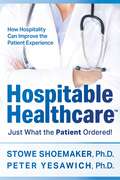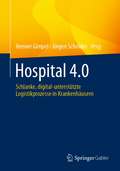- Table View
- List View
Hope: An Essential Element of Resonant Leadership
by Annie Mckee Richard BoyatzisLeaders develop their resonance and renew themselves by cultivating three essential elements: mindfulness, hope, and compassion. This chapter explores hope and how effective leaders cultivate it to sustain resonance and to guide their decisions and future actions.
Hopital Universitaire de Mirebalais, Partners In Health in Haiti
by Robert S. Kaplan Karla Bertrand Bipin MistryThe case describes the application of Time-Driven Activity-Based Costing (TDABC) at a new tertiary hospital, operated by Partners-in-Health in Mirebelais, Haiti. A project team mapped the clinical processes for use in estimating the direct costs of personnel, equipment, and facilities for obstetric and breast cancer care. The accurate cost information revealed opportunities to optimize resource-utilization and reduce costs by establishing more efficient sterilization procedures and task-shifting administrative responsibilities away from high-cost physicians. It would also potentially be used for budgeting and to propose new payment models with Haiti's Ministries of Health and Finance.
Hopping over the Rabbit Hole: How Entrepreneurs Turn Failure into Success
by Anthony Scaramucci Tony Robbins Peter DiamandisDevelop the Scaramucci mindset that drives entrepreneurial success Hopping over the Rabbit Hole chronicles the rise, fall, and resurgence of SkyBridge Capital founder Anthony Scaramucci, giving you a primer on how to thrive in an unpredictable business environment. The sheer number of American success stories has created a false impression that becoming an entrepreneur is a can't-miss endeavor--but nothing could be further from the truth. In the real world, an entrepreneur batting .150 goes directly to the Hall of Fame. Things happen. You make a bad hire, a bad strategic decision, or suffer the consequences of an unforeseen market crash. You can't control what happens to your business, but you can absolutely control how you react, and how you turn bumps in the road into ramps to the sky. Anthony Scaramucci has been there and done that, again and again, and has ultimately come out on top; in this book, he shares what he wishes he knew then. Your chances of becoming an overnight billionaire are approximately the same as your chances of being signed to the NBA. Success is hard work, and anxiety, and tiny hiccups that can turn into disaster with a single misstep. This book shows you how to use adversity to your ultimate advantage, and build the skills you need to respond effectively to the unexpected. Learn how to deal with unforeseen events Map a strategic backup plan, and then a backup-backup plan Train yourself to react in the most productive way Internalize the lessons learned by a leader in entrepreneurship For every 23-year-old billionaire who just created a new way to send a picture on a phone, there are countless others who have failed, and failed miserably. Hopping over the Rabbit Hole gives you the skills, insight, and mindset you need to be one of the winners.
Horizontal Development: Shifting Power and Privilege in Aid
by Anne-Meike Fechter Thabani Mutambasere Shonali BanerjeeAccessible and comprehensive, this book puts forth an innovative perspective on international aid, going beyond top-down attempts to centre local voices and practices. By providing an overview of newer iterations and overlooked practices in development, including citizen aid, technologies for development, and faith-based humanitarianism, the book explores the extent to which they disrupt existing models and potentially lead to more equitable grassroots-led approaches. The authors develop the concept of 'horizontal development' to examine how power and privilege operate in international and local horizontal development spaces. Examining challenges, they also highlight opportunities for doing things differently in light of prominent calls for decolonising aid and development.
Horizontal Equity, Uncertainty, and Economic Well-being
by Timothy Smeeding Martin DavidThe result of a National Bureau of Economic Research Income and Wealth conference held in December 1983, this volume looks at the concept of "economic well-being" and the ways that analysts have tried to measure it. In addition to income, economists have begun to consider such factors as pensions, wealth, health, and environment when measuring the well-being of a particular group. They have also begun to measure how consumers respond, successfully or unsuccessfully, to such economic uncertainties as inflation, divorce, and retirement. Using new data and techniques, the contributors to this book concentrate on issues of uncertainty and horizontal equity (the equal treatment of individuals within a defined group). Their work points to better ways of determining how various groups in a society are faring relative to other groups. Economists and policy analysts, therefore, will be in a better position to determine how government programs should be applied when well-being is used as a test.
Hormones, Talent, and Career: Unlock Your Hormonal Quotient®
by Diana Derval Johan BremerThe media now regularly feature breakthroughs on the influence of prenatal hormones on the brain and behavior, for instance the link to financial performance or risk management. Based on these findings and their own experiments, the authors present the Hormonal Quotient (HQ) as a scientific, holistic and reliable career management and personal development tool for professionals. Eight HQ profiles and their corresponding typical business skills and preferences are presented and enable the reader to benchmark their HQ with peers, design an ideal career plan, build a winning team in business and find the perfect work-life balance. A complimentary website allows readers to easily measure their HQ online. By the author of "The Right Sensory Mix", Berry-AMA Book Prize Finalist 2011.
Horngren's Accounting: The Managerial Chapters
by Brenda Mattison Tracie L. Miller-Nobles Ella MatsumuraHorngren's Accounting, The Managerial Chapters present the core principles of accounting in a fresh format designed to help today's learners succeed. As teachers first, the author team knows the importance of delivering a reader experience free of obstacles. Their pedagogy and content uses leading methods in teaching critical foundational topics and concentrates on improving results--all tested in class by the authors themselves. With this in mind, the 12th Edition continues to focus on readability and comprehension, and takes this a step further in the managerial chapters by employing a new theme to help readers see how managerial accounting is used as a tool to help all business people make decisions. By providing more meaningful learning tools, this title helps readers clear hurdles like never before.
Horngren's Cost Accounting
by Charles T. Horngren Srikant M. Datar Madhav V. RajanHorngren's Cost Accounting defines the cost accounting market and continues to innovate today by consistently integrating the most current practice and theory into the text. This acclaimed, market-leading text emphasizes the basic theme of "different costs for different purposes," and reaches beyond cost accounting procedures to consider concepts, analyses, and management. The 16th Edition incorporates the latest research and most up-to-date thinking into all relevant chapters, so that readers are prepared for the rewards and challenges they will face in the professional cost accounting world of today and tomorrow.
Horngren's Cost Accounting
by Srikant Datar Madhav RajanHorngren’s Cost Accounting expertly explains the cost accounting market. This acclaimed text emphasizes the basic theme of “different costs for different purposes". It reaches beyond cost accounting procedures to consider concepts, analyses and management. The authors continue to innovate with the 17th Edition by consistently integrating the most current research, practice and theory. Each chapter will prepare you for the rewards and challenges you’ll face in the professional cost accounting world of today and tomorrow.
Horngren's Financial & Managerial Accounting: The Financial Chapters, Fifth Edition
by Trade Miller-Nobles Brenda Mattison Ella Mae MatsumuraExpanding on Proven Success with Horngren's Financial and Managerial Accounting Horngren’s Financial and Managerial Accounting presents the core content of the accounting course in a fresh format designed to help today’s learners succeed. The Eleventh Edition expands on the proven success of the significant revision to the Horngren franchise and uses what the authors have learned from focus groups, market feedback, and colleagues to create livelier classrooms, provide meaningful learning tools, and give professors resources to help students inside and outside the class. First, the authors ensured that content was clear, consistent, and above all, accurate. Every chapter is reviewed to ensure that students understand what they are reading and that there is consistency from chapter to chapter. The author team worked every single accounting problem and employed a team of accounting professors from across the nation to review for accuracy.
Horse Economics
by Catherine E O'BrienMost horse owners don't have unlimited disposable income, and, unfortunately, equine-related financial decisions are often driven by their passion rather than sound, long-range planning. Here, the author explains how this potentially disastrous scenario can be avoided with the appropriate preparation. Horse Economics helps illustrate a complete financial picture for the horse owner, first by determining the true costs of horse ownership, and then incorporating these added expenses into a household budget. Chapters include information on managing credit, debt, retirement, and investment, as well as an extensive examination of purchasing, owning, maintaining, and selling horse property. The book also includes helpful worksheets for calculating net worth, cash flow, and more.
Horse Trading in the Age of Cars: Men in the Marketplace (Gender Relations in the American Experience)
by Steven M. GelberThe trading, selling, and buying of personal transport has changed little over the past one hundred years. Whether horse trading in the early twentieth century or car buying today, haggling over prices has been the common practice of buyers and sellers alike. Horse Trading in the Age of Cars offers a fascinating study of the process of buying an automobile in a historical and gendered context. Steven M. Gelber convincingly demonstrates that the combative and frequently dishonest culture of the showroom floor is a historical artifact whose origins lie in the history of horse trading. Bartering and bargaining were the norm in this predominantly male transaction, with both buyers and sellers staking their reputations and pride on their ability to negotiate the better deal. Gelber comments on this point-of-sale behavior and what it reveals about American men. Gelber's highly readable and lively prose makes clear how this unique economic ritual survived into the industrial twentieth century, in the process adding a colorful and interesting chapter to the history of the automobile.
Horses for Courses: An Irish Racing Year
by Anne HollandThere can be no better way of getting to know Ireland than by visiting its racecourses: from the glamour of Leopardstown and the class of The Curragh to the majestic mountains around Killarney; from the warm welcome at Gowran Park and Clonmel to the summer holidaymakers' meetings and 'industry' days in the winter months. At any one of these venues, you might catch a glimpse of a future Cheltenham Gold Cup champion or Derby winner in action.Horses for Courses guides readers through a typical year in Irish racing and highlights the individuality of each venue. All have their own special qualities and atmosphere but share two common traits: a warm welcome and good sport. And that is what the author believes Irish racing is all about.The country's courses enjoy a huge level of support from the local population. It might be raining and some of the races may be 'ordinary' but the stands will always be crowded. That is because racing is part of Irish culture and the nation's way of life: with 27 courses, it has proportionately far more venues than Great Britain.Meticulously researched and passionately written, Horses for Courses is the definitive guide to Ireland's racecourses and is essential reading for horse-racing enthusiasts everywhere.
Horst Dassler, Adidas, and the Commercialization of Sport
by Geoffrey G. Jones Michael Norris Sophi KimThe case focuses on the career of Horst Dassler, the son of the founder of the German-based sports shoe manufacturer Adidas. The origins of the firm were in the interwar years, and it rose to public prominence after it provided spikes for the famous African-American sprinter in the 1936 Berlin Olympics. From the 1950s Horst cultivated relationships with athletes and national associations to expand his sports apparel business and develop sports sponsorship, competing fiercely against competitors such as Puma and Nike. During the 1970s he played a key role in commercializing the international soccer federation FIFA, including creating a television market for soccer, and he subsequently became a key force behind arranging sponsorships and broadcasting rights for the Olympics. The case explores the drivers of success of this major consumer brand, and provdes the opportunity to discuss the positives and negatives of the globalization and commercialization of sport.
Hoshin Kanri for Healthcare: Toyota-Style Long-Term Thinking and Strategy Deployment to Unlock Your Organization’s True Potential
by Gerard A. Berlanga Brock C. Husby Heather K. AndersonThe best healthcare organizations have developed effective approaches to develop compelling strategic visions and strategies based on long-term thinking and continue to apply Lean principles across their organizations to create a culture of continuous improvement. Establishing effective strategies and Toyota style Hoshin Kanri enables healthcare organizations to align everyone in the organizations and creates a unique competitive advantage. This book follows a regional hospital's journey through the creation of long-term strategic goals and Toyota Style strategy deployment.
Hoshin Kanri for the Lean Enterprise: Developing Competitive Capabilities and Managing Profit
by Thomas L. JacksonWinner of a Shingo Research and Professional Publication Award!At the heart of Lean and Six Sigma is the same, unique business operating system: hoshin kanri. It is a method of strategic planning and a tool for managing complex projects, a quality operating system geared to ensuring that organizations faithfully translate the voice of the customer into new products, and a business operating system that ensures reliable profit growth.The true power of hoshin kanri, however, is two-fold -- it is a superior organizational learning method as well as a competitive resource development system.Hoshin Kanri for the Lean Enterprise, by Tom Jackson, explains how you can implement, identify and manage the critical relationships among your markets, design characteristics, production systems, and personnel to satisfy your customers and beat your competition. This practical workbook provides— A new understanding of hoshin kanri as a grand experimental design implemented through a system of team agreements. Clear explanations of the steps of hoshin kanri. A measure of overall business effectiveness used to determine the focus of corporate strategy. A new, improved X-matrix that incorporates a lean "balanced scorecard" for identifying improvement opportunities and converting them readily into bottom line results as a value stream P&L in terms that financial managers and accountants can understand and support. Downloadable resources containing forms, meeting agendas, and examples of X-matrices that serve marketing and design engineering as well as manufacturing. This workbook will show you the mechanics of implementing hoshin kanri, so that you can systematically improve your brand equity, implement Lean manufacturing and Six Sigma, and integrate your suppliers into a Lean and Six Sigma organization.
Hoshin Kanri in Higher Education: A Guide to Strategy Development, Deployment, and Management
by William K. Balzer Tammi SinhaStrategy, the link between mission and operational plans to improve an institution’s performance, is a critical element to the future success of higher education (HE). Hoshin Kanri (HK), the application of Lean principles and practices to strategy development, deployment, and management, is a systematic and effective approach to support institutional success, particularly when competition is high. Surprisingly, despite its known effectiveness and advantages over other approaches to strategy development, deployment, and management, the application of HK in HE is limited. This book promotes greater awareness, appreciation, and application of HK at HE institutions. The book is divided into four sections: The first section (Introduction to Hoshin Kanri) provides a general overview of HK and its potential contributions when used in HE settings. The second section (Case Studies) provides several examples where aspects of HK were introduced at HE institutions. These case studies, which vary in scope, use of HK practices and tools, and identified benefits, offer insights both for helping senior leaders recognize the value of HK (and adopt the HK process) and for on-the-ground experiences using HK tools and techniques – including barriers and challenges – during implementation. The third section (Expanding the Application of Hoshin Kanri in Higher Education) includes several chapters on how to begin an HE institution’s HK journey. The chapters include practical steps for gaining support for and implementing HK strategy development, deployment, and management tailored for HE institutions across both typical and novel applications of HK. The fourth and final section (Implications for Practice and Research) presents a high-level summary of the "current state" of HK in HE and offers thoughts and recommendations on the "future state" directions for practice, research opportunities, and challenges for HK in HE. The book underscores the key benefits HK can offer HE institutions. With its Lean roots of continuous improvement and respect for people, HK offers HE institutions an effective and sustainable approach to strategy development, deployment, and management. HK can be used institution-wide or at any level or area within an institution. While the local application of HK won’t achieve the full benefits possible through institution-wide adoption, it offers a marked improvement over other strategy approaches that fail to respect people and leverage their knowledge, expertise, and insights to apply continuous improvement to move their office, department, or function forward.
Hoshin Kanri: Policy Deployment for Successful TQM
by Yoji AkaoFor Florida Power and Light, Hewlett-Packard, and Texas Instruments, policy deployment has created a critical bridge between corporate goals and their company-wide deployment. Hoshin Kanri offers top and middle managers a guide to customizing a policy deployment program especially suited to their company.This book is a compilation of examples of policy deployment and demonstrates how company vision is converted into individual responsibility. It contains practical guidelines, 150 charts and diagrams, and five case studies that illustrate the procedures of Hoshin Kanri. The six steps to advanced process planning are reviewed and include: a five-year vision; one-year plan; deployment to departments; execution; monthly audit; and annual audit. The practice of Hoshin Kanri will enable you to: Align all departmental and individual project goals to corporate goals and eliminate duplication of effort.Communicate to every employee his or her role in achieving the company vision.Closely monitor performance using carefully devised measures of progress.Learn how Hoshin Kanri can increase your company's responsiveness to social, economic, and technical changes through flexible strategic management. (Originally published by the Japanese Standards Association)
Hoshin Kanri: Policy Deployment for Successful TQM
by Yoji AkaoFor Florida Power and Light, Hewlett-Packard, and Texas Instruments, policy deployment has created a critical bridge between corporate goals and their company-wide deployment. Hoshin Kanri offers top and middle managers a guide to customizing a policy deployment program especially suited to their company. This book is a compilation of examples of policy deployment and demonstrates how company vision is converted into individual responsibility. It contains practical guidelines, 150 charts and diagrams, and five case studies that illustrate the procedures of Hoshin Kanri. The six steps to advanced process planning are reviewed and include: a five-year vision; one-year plan; deployment to departments; execution; monthly audit; and annual audit. The practice of Hoshin Kanri will enable you to: Align all departmental and individual project goals to corporate goals and eliminate duplication of effort. Communicate to every employee his or her role in achieving the company vision. Closely monitor performance using carefully devised measures of progress. Learn how Hoshin Kanri can increase your company's responsiveness to social, economic, and technical changes through flexible strategic management.(Originally published by the Japanese Standards Association)
Hoshin Kanri: The Strategic Approach to Continuous Improvement
by David HutchinsThe results of the quality revolution have been mixed. Global competition has elevated the most successful companies, in terms of providing goods and services, but even then initiatives such as total quality, business process re-engineering and Six Sigma have been heralded as the solution, only to have been replaced with the next 'big thing' when it came along. Hoshin Kanri is not the next big thing in quality, it is a strategic approach to continuous improvement that provides a context for all of the individual elements such as Six Sigma or Lean Manufacturing. David Hutchins' Hoshin Kanri shows you how to develop a dynamic vision for continuous improvement; to implement effective policies to support it; to link key performance indicators to Six Sigma, Lean Manufacturing and Kaizen and to sustain a strategy-led programme for improving business performance.
Hospice Palliative Home Care and Bereavement Support: Nursing Interventions and Supportive Care
by Lorraine Holtslander Shelley Peacock Jill BallyThis book provides an unique resource for registered nurses working in hospice palliative care at home and for the community, outside of acute care settings and also incorporates literature related to palliative care in acute health care settings, as part of the overall services and supports required. Very few resources exist which specifically address hospice palliative care in the home setting, despite the fact that most palliative care occurs outside acute care settings and is primarily supported by unpaid family caregivers. An overview of the concerns for individuals and families, as well as specific nursing interventions, from all ages would be an excellent support for nursing students and practicing registered nurses alike.The book structure begins with a description of the goals and objectives of hospice palliative care and the nursing role in providing excellent supportive care. Chapters include research findings and specifically research completed by the authors in the areas of pediatric palliative care, palliative care for those with dementia, and the needs of family caregivers in bereavement. Interventions developed by the editors are provided in this book, such as the “Finding Balance Intervention” for bereaved caregivers; the “Reclaiming Yourself” tool for bereaved spouses of partners with dementia; and The Keeping Hope Possible Toolkit for families of children with life threatening and life limiting illnesses. The development and application of these theory-based interventions are also highlighted. Videos and vignettes written by family caregivers about what was helpful for them, provide a patient-and family-centered approach.The book will benefit nursing students, educators and practicing registered nurses by providing information, theory, and evidence from research.
Hospitable Healthcare: Just What the Patient Ordered!
by Stowe Shoemaker Peter Yesawich&“We thought we knew what patients needed..."– Dr. James Merlino, Cleveland ClinicMost consumers agree their service experiences with hospitals, clinics, and physicians fall well short of their service experiences with hotels, resorts, and restaurants. So, what would their experiences be like if healthcare providers served them the same way hospitality providers do? Given that both industries share many common service touchpoints, one wonders whether healthcare service providers could adopt principles of hospitality to enhance the patient experience. The insights shared in this book reveal the answer: yes! Rich with original survey data, examples, and interviews with widely admired hospitality and healthcare service practitioners, Hospitable Healthcare is a valuable resource guaranteed to enhance the patient experience. The first of its kind, Hospitable Healthcare introduces healthcare providers to an original service model based on principles the hospitality industry has used to create great guest experiences: PAEER (for Prepare, Anticipate, Engage, Evaluate, Reward). The model addresses four trends impacting healthcare: more patient-directed selection of healthcare service providers; greater transparency in the pricing of healthcare services to promote competition; more direct-to-consumer marketing to attract new patients; and the growing importance of patient satisfaction when payors determine reimbursement. As Shoemaker&’s and Yesawich&’s work reveals, Hospitable Healthcare is indeed just what the patient ordered!
Hospital 4.0: Schlanke, digital-unterstützte Logistikprozesse in Krankenhäusern
by Jürgen Schröder Henner GimpelDie medizinischen und pflegerischen Kernprozesse eines Krankenhauses werden durch zahlreiche Logistikprozesse unterstützt, die hohe Anforderungen an Qualität, Individualisierung, Echtzeitreaktionsfähigkeit und Kosteneffizienz stellen. Dennoch trifft man häufig auf Verschwendungen von wichtigen Ressourcen, wie Material, Fläche oder Arbeit. Schlanke Logistikprozesse sind leider eher selten. Um Logistikprozesse auf die Kernprozesse auszurichten, fokussiert sich dieses Buch auf die Weiterentwicklung von innovativen Logistiksystemen in Krankenhäusern. Hier liegt Potenzial, das durch die Digitalisierung der Logistikprozesse gehoben werden kann.Im Detail werden zwei Referenzmodelle zur „Materiallogistik“ und der „Bettenlogistik“, vorgestellt, die ein Konzept für digital-unterstützte, verschwendungsarme Logistikprozesse in Kliniken aufzeigen. Darüber hinaus werden Methoden zur Anwendung der Referenzmodelle erläutert. Diese Erkenntnisse stammen aus einem angewandten Forschungsprojekt mit zwei Krankenhäusern der maximalen Versorgungsstufe in Süddeutschland.
Hospital 57357: Aligning Performance Towards a Vision of a Cancer-Free Childhood
by Susanna Gallani Youssef Abdel AalThe case follows the Children Cancer Hospital in Egypt, also known as Hospital 57357, as it goes through the roll-out of a new performance management system, which Dr. Sherif Abouel Naga, founder and CEO of the hospital, had championed. This was a critical juncture as the largest pediatric cancer hospital in the world was transitioning from a traditional, relatively informal operating style to a performance management system that was tightly structured and data driven. Dr. Abouel Naga had tasked a newly assembled management team with defining a strategy to ensure that 57357 remained a world leader in quality healthcare for children with cancer in an evolving and uncertain market landscape. While Dr. Abouel Naga was confident that a system that measured each individual's contribution to the strategy would make a difference in the overall performance of the organization, critics worried about how employees might respond to the tight structure that came with this system. How could they ensure there would still be plenty of room for creativity and innovation, which were so important in the delivery of care? Would the new system allow to adapt quickly to evolving market conditions without generating confusion among the staff?

